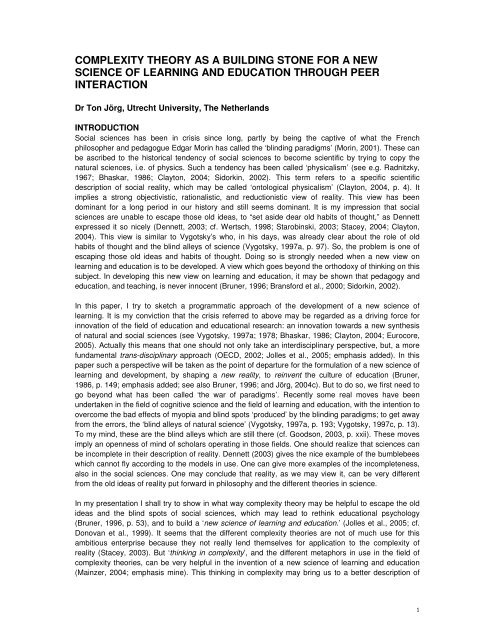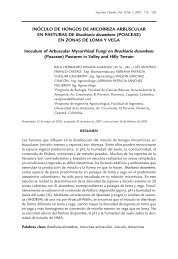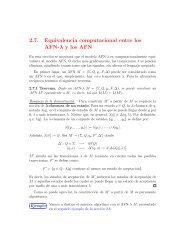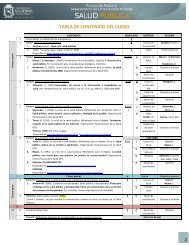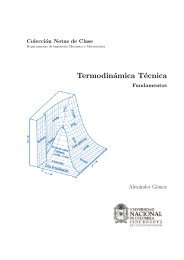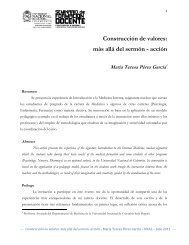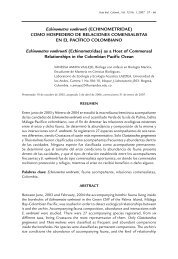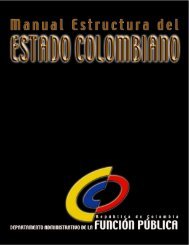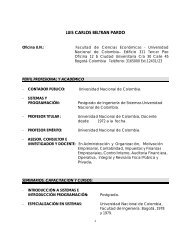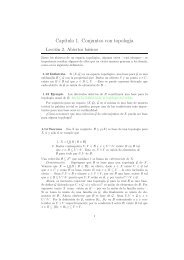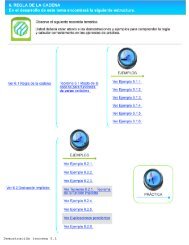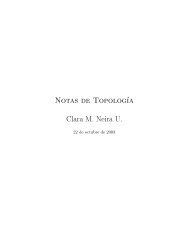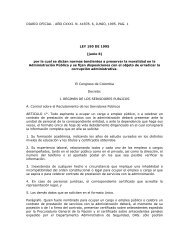complexity theory as a building stone for a new science ... - UN Virtual
complexity theory as a building stone for a new science ... - UN Virtual
complexity theory as a building stone for a new science ... - UN Virtual
You also want an ePaper? Increase the reach of your titles
YUMPU automatically turns print PDFs into web optimized ePapers that Google loves.
COMPLEXITY THEORY AS A BUILDING STONE FOR A NEWSCIENCE OF LEARNING AND EDUCATION THROUGH PEERINTERACTIONDr Ton Jörg, Utrecht University, The NetherlandsINTRODUCTIONSocial <strong>science</strong>s h<strong>as</strong> been in crisis since long, partly by being the captive of what the Frenchphilosopher and pedagogue Edgar Morin h<strong>as</strong> called the ‘blinding paradigms’ (Morin, 2001). These canbe <strong>as</strong>cribed to the historical tendency of social <strong>science</strong>s to become scientific by trying to copy thenatural <strong>science</strong>s, i.e. of physics. Such a tendency h<strong>as</strong> been called ‘physicalism’ (see e.g. Radnitzky,1967; Bh<strong>as</strong>kar, 1986; Clayton, 2004; Sidorkin, 2002). This term refers to a specific scientificdescription of social reality, which may be called ‘ontological physicalism’ (Clayton, 2004, p. 4). Itimplies a strong objectivistic, rationalistic, and reductionistic view of reality. This view h<strong>as</strong> beendominant <strong>for</strong> a long period in our history and still seems dominant. It is my impression that social<strong>science</strong>s are unable to escape those old ide<strong>as</strong>, to “set <strong>as</strong>ide dear old habits of thought,” <strong>as</strong> Dennettexpressed it so nicely (Dennett, 2003; cf. Wertsch, 1998; Starobinski, 2003; Stacey, 2004; Clayton,2004). This view is similar to Vygotsky’s who, in his days, w<strong>as</strong> already clear about the role of oldhabits of thought and the blind alleys of <strong>science</strong> (Vygotsky, 1997a, p. 97). So, the problem is one ofescaping those old ide<strong>as</strong> and habits of thought. Doing so is strongly needed when a <strong>new</strong> view onlearning and education is to be developed. A view which goes beyond the orthodoxy of thinking on thissubject. In developing this <strong>new</strong> view on learning and education, it may be shown that pedagogy andeducation, and teaching, is never innocent (Bruner, 1996; Brans<strong>for</strong>d et al., 2000; Sidorkin, 2002).In this paper, I try to sketch a programmatic approach of the development of a <strong>new</strong> <strong>science</strong> oflearning. It is my conviction that the crisis referred to above may be regarded <strong>as</strong> a driving <strong>for</strong>ce <strong>for</strong>innovation of the field of education and educational research: an innovation towards a <strong>new</strong> synthesisof natural and social <strong>science</strong>s (see Vygotsky, 1997a; 1978; Bh<strong>as</strong>kar, 1986; Clayton, 2004; Eurocore,2005). Actually this means that one should not only take an interdisciplinary perspective, but, a morefundamental trans-disciplinary approach (OECD, 2002; Jolles et al., 2005; emph<strong>as</strong>is added). In thispaper such a perspective will be taken <strong>as</strong> the point of departure <strong>for</strong> the <strong>for</strong>mulation of a <strong>new</strong> <strong>science</strong> oflearning and development, by shaping a <strong>new</strong> reality, to reinvent the culture of education (Bruner,1986, p. 149; emph<strong>as</strong>is added; see also Bruner, 1996; and Jörg, 2004c). But to do so, we first need togo beyond what h<strong>as</strong> been called ‘the war of paradigms’. Recently some real moves have beenundertaken in the field of cognitive <strong>science</strong> and the field of learning and education, with the intention toovercome the bad effects of myopia and blind spots ‘produced’ by the blinding paradigms; to get awayfrom the errors, the ‘blind alleys of natural <strong>science</strong>’ (Vygotsky, 1997a, p. 193; Vygotsky, 1997c, p. 13).To my mind, these are the blind alleys which are still there (cf. Goodson, 2003, p. xxii). These movesimply an openness of mind of scholars operating in those fields. One should realize that <strong>science</strong>s canbe incomplete in their description of reality. Dennett (2003) gives the nice example of the bumblebeeswhich cannot fly according to the models in use. One can give more examples of the incompleteness,also in the social <strong>science</strong>s. One may conclude that reality, <strong>as</strong> we may view it, can be very differentfrom the old ide<strong>as</strong> of reality put <strong>for</strong>ward in philosophy and the different theories in <strong>science</strong>.In my presentation I shall try to show in what way <strong>complexity</strong> <strong>theory</strong> may be helpful to escape the oldide<strong>as</strong> and the blind spots of social <strong>science</strong>s, which may lead to rethink educational psychology(Bruner, 1996, p. 53), and to build a ‘<strong>new</strong> <strong>science</strong> of learning and education.’ (Jolles et al., 2005; cf.Donovan et al., 1999). It seems that the different <strong>complexity</strong> theories are not of much use <strong>for</strong> thisambitious enterprise because they not really lend themselves <strong>for</strong> application to the <strong>complexity</strong> ofreality (Stacey, 2003). But ‘thinking in <strong>complexity</strong>’, and the different metaphors in use in the field of<strong>complexity</strong> theories, can be very helpful in the invention of a <strong>new</strong> <strong>science</strong> of learning and education(Mainzer, 2004; emph<strong>as</strong>is mine). This thinking in <strong>complexity</strong> may bring us to a better description of
eality of learning and development and education, opening our very eyes <strong>for</strong> all of its inherent detailand dynamic <strong>complexity</strong>.My focus is on learning and development, and the <strong>theory</strong> of it, from a Vygotskian perspective, to betaken <strong>as</strong> social processes of learning and development through communicative human interaction.Such a <strong>theory</strong> may be regarded <strong>as</strong> being “at the same time a <strong>theory</strong> of education.” (Bruner, 1962, p. v)The interaction with all of its complex dynamics and effects is simultaneously both social andindividual. This view is fully in line with the view of Ralph Stacey who, in his book “Complexity andgroup processes”, starts with the radical social understanding of the individual (Stacey, 2003). What isneed, now, is not only a different description of reality, but also the development of a differentexplanation of the reality of human interaction, by the recognition of the <strong>complexity</strong> of it. This<strong>complexity</strong> of interaction is too e<strong>as</strong>ily taken <strong>for</strong> granted in practice. It is my firm conviction that wereally need to open our minds, like Darwin did in his days, to be able to view reality differently: bycomplexifying and liquefying that very reality. What we need is an evolutionary integrative perspectiveof the causal dynamics of interaction to explain the <strong>complexity</strong> of reality, <strong>as</strong> being both detail anddynamic <strong>complexity</strong>. Inventing a <strong>new</strong> reality seems only possible by introducing a <strong>new</strong> language, andan adequate vocabulary (Maruyama, 1961), to enable both the description and the possibilities ofexplanation of the <strong>new</strong> reality (Bruner, 1986; Davis et al., 2000). It will be a language with many <strong>new</strong>concepts and metaphors, fostering a different description ànd explanation of the object of study: thelearning and development of peers <strong>as</strong> partners in communicative interaction. This language shouldfocus on a <strong>new</strong> synthesis of natural and social <strong>science</strong>s (Vygotsky, 1978; Eurocore, 2005). Doing someans that we should start with rethinking: rethinking of interaction, and of <strong>complexity</strong>, to be able toreinvent reality <strong>as</strong> dynamic and fluid (Jörg, 2004c). The role of time, which is often neglected in thescientific approach of learning and education, is of utmost importance in this. Only by taking the role oftime seriously we may become explanatory about the way processes can produce the effects we may<strong>as</strong>sesals in reality.For a <strong>new</strong> <strong>science</strong> of learning and education we need a rethinking of the notion of learning of theindividual, and start with the radical social understanding of individuals and their learning in humaninteraction. Taking this perspective it means a rethinking of how individuals learn through interaction.Figure 1Relationship between theories <strong>for</strong> use in theorizing aboutlearning and development
Interaction itself needs a rethinking too!. History shows that interaction itself is a difficult concept, alsoin physics, with fundamental problems <strong>for</strong> understanding what is going on in the complex processesinvolved. I agree with Stacey (2003) that we need an adequate process <strong>theory</strong> of interaction. So, itseems a good idea to start with the problem of interaction <strong>as</strong> a concept. A concept which is so much inuse in natural and social <strong>science</strong>s, but, regularly, not very well understood (Starobinski, 2003). Thedescription and explanation of the <strong>complexity</strong> of interaction, with its inherent causal dynamics <strong>as</strong>characteristic <strong>for</strong> the <strong>complexity</strong> of it (Vygotsky, 1978), can be viewed <strong>as</strong> the corner <strong>stone</strong> of a <strong>new</strong><strong>science</strong> of learning and development. It w<strong>as</strong> also Vygotsky who draw an analogy between the processof child development and the processes of evolution (Vygotsky, 1997c, p. 99). He wrote, already in1926, about the socio-biological foundation of educational psychology (Vygotsky, 1997b, p. xix). Hefirmly rejected Darwin’s notion of evolution <strong>as</strong> (only) gradual change, <strong>as</strong> well <strong>as</strong> the common notion ofunfolding, still popular in our days (see e.g. Van Gelder & Port, 1995, p. 3). His original evolutionaryperspective is another corner <strong>stone</strong> <strong>for</strong> dealing with the nature and <strong>complexity</strong> of learning anddevelopment. He focuses on the growth of the whole person, with his/ her whole mind, viarelationships (cf. Stacey, 2003, p. 5). The dependence of internal mental functions on socialrelationships is essential <strong>for</strong> that growth (cf. Vygotsky, 1997c, p. 105). These relationships of twopeople, to be taken <strong>as</strong> a <strong>new</strong> unit, of ‘the ensemble <strong>as</strong> a process’ (Granott, 1998), are reciprocal fromthe very beginning of child’s history of development. The ensemble is dynamic and changing (Ibid., p.61). One may call these relationships within an ensemble growth relationships, leading children to <strong>new</strong>states of growth. These states can be regarded <strong>as</strong> qualitatively different (Vygotsky, 1978).Summarizing the view sketched above, I seriously take the challenge of the invention of the <strong>new</strong><strong>science</strong> of learning we need (Kaufman, 1995, p. 304; OECD, 2002; Jolles et al., 2005), by starting withthe connection between learning <strong>theory</strong>, <strong>complexity</strong> <strong>theory</strong>, and evolution <strong>theory</strong>: see figure 1 of thetriangular relationship between these theories. This relationship, now, is foundational <strong>for</strong> a <strong>new</strong><strong>science</strong> of learning and development, focusing on growth of the whole person, of the whole mind, inand through communicative human interaction within (reciprocal) ‘learningful’ relationships. It is anecessary condition to connect this <strong>new</strong> <strong>science</strong> with concrete practical reality (Knox & Stevens, 1993,p. 12)What is needed is a rethinking of educational psychology, and to reinvent the culture of education too!(Bruner, 1986, p. 149; emph<strong>as</strong>is added) This goal may lead to a sketch of the generative powers ofthe communicative use of language in learning and thinking, to be linked with the inherent causaldynamics of interaction <strong>as</strong> reciprocal influencing one another in time. The focus should be on both thedescription and the explanation of the processes of ‘bootstrapping’ of each other in social interaction;a ‘bootstrapping’ of each other <strong>as</strong> a process of social interaction with potentially non-linear effects onthe partners of the ensemble <strong>as</strong> the <strong>new</strong> unit of study (see Bruner, 1996; Van Geert, 1991; Granott,1998). This description and explanation demands <strong>for</strong> a <strong>new</strong> methodology <strong>as</strong> well (Azmitia, 1996, p.133). Needed <strong>for</strong> this is a <strong>new</strong> adequate vocabulary of interaction and the <strong>complexity</strong> of it; it could bedone in terms known from the different <strong>complexity</strong> theories, to be linked with the evolutionaryperspective of learning <strong>as</strong> states of growth and development of the persons involved in interaction.The concepts of generative processes and generativity are essential <strong>for</strong> such a description andexplanation. Consequently, time will have an essential role in this. The <strong>new</strong> <strong>science</strong> of learning, then,may bring us to better concepts of both the learner, the learning <strong>as</strong> a process, and of the learningeffects, <strong>as</strong> fundamentally intertwined dynamic concepts. The mind h<strong>as</strong> a fundamental, dynamic role inthis complex process (cf. Tharp & Gallimore, 1993; Port & Van Gelder, 1995; Azmitia, 1996; andWertsch, 1998).INTERACTIONLearning through human interaction h<strong>as</strong> long been a topic of interest in the fields of psychology andeducation without being understood very well. Interaction itself seems to be the problem: this conceptappeared only in the second half of the 19th century (see Starobinski, 2003). Its <strong>complexity</strong> <strong>as</strong> aprocess h<strong>as</strong> been neglected <strong>for</strong> long in history. This h<strong>as</strong> been true <strong>for</strong> psychology and the field ofeducation <strong>as</strong> well. Learning through interaction is not a dominant view in those fields. The notion ofinteraction within a dyad, including the relationship between the two, is not very common. The
common view taken to describe what happens in such interaction is almost unanimously an unilateralview. Mostly, the description simply lacks the notion of circularity of the communicative interactionbetween the partners involved in that interaction (Watzlawick et al., 1967, p. 157). So, it may not come<strong>as</strong> a surprise that the field of education is still waiting <strong>for</strong> an adequate <strong>theory</strong> of interaction, notknowing how it would look like (Bates et al., 1998).Stacey (2003) w<strong>as</strong> very clear in his stating of the need <strong>for</strong> a process <strong>theory</strong> of interaction (p. 4). I fullyagree with Stacey that <strong>complexity</strong> theories can be of use in describing theories of (complex)interaction (Ibid., p. 4). But I do not agree with his statement that there is not such a thing <strong>as</strong> a system,but only process (Ibid., p. 5). I think the concept of the ensemble <strong>as</strong> a dynamic unity of dynamicallyevolving minds in interaction, via mind-to-mind causation (Granott, 1998; Bh<strong>as</strong>kar, 2002), is a betterstart <strong>for</strong> description and explanation of interaction <strong>as</strong> a process. This description is also in line with theone given by Stacey (2003) himself on the use of minds in social interaction, producing that socialinteraction while simultaneously being <strong>for</strong>med by that social interaction (Stacey, 2003, p. 2). Bothdescriptions <strong>as</strong>k <strong>for</strong> a kind of rethinking interaction, with its inherent <strong>complexity</strong>: a <strong>complexity</strong> whichh<strong>as</strong> been taken <strong>for</strong> granted too long. I would like to suggest the metaphor of ‘bootstrapping’ each other<strong>as</strong> a time-dependent process taking place within a so-called ‘reciprocal learning relation’. Thissuggestion of describing interaction between two people <strong>as</strong> bootstrapping each other <strong>as</strong> a complexprocess of interaction within the unity of the ensemble of a reciprocal relationship between two peopleis, like Stacey’s, <strong>as</strong> much b<strong>as</strong>ed on “a unitary, paradoxical causality of emergent continuity andtrans<strong>for</strong>mation at the same time.“ (Stacey, 2003, p. 280; emph<strong>as</strong>is added) This description ofinteraction, now, is already pretty complex. Yet, it offers only a description, and not an explanation ofthe process of interaction. For a more explanatory view of interaction we may need differentconceptual tools. Tools which are in use in different disciplines, like in the <strong>complexity</strong> theories in use inthe natural <strong>science</strong>s. These theories, now, may offer the possibility of modelling interaction from amore explanatory point of view. Such modelling can be done by taking the perspective of interaction<strong>as</strong> a circular process, making use of (hitherto unknown) causally generative mechanisms (Bh<strong>as</strong>kar,1986): both in qualitative and in quantitative terms. Modelling of long-term repeated interaction <strong>as</strong>bootstrapping of each other between two people, within their dyadic reciprocal relationship, offers aprocess with unexpected potentially non-linear effects on both partners in the process. The processesinvolved may be described <strong>as</strong> autocatalytic and cross-catalytic in nature (cf. Kaufman, 1995). Theyenable not only the enhancement of the growth of minds involved in the interaction (cf. Stacey, 2003,p. 2), but also how this may happen through the strengthening of connections between the two mindsin interaction. The combination of changes, of the minds themselves and the connection between thetwo minds, may be responsible <strong>for</strong> the generative powers of communicative human interaction(Bruner, 1986). This bootstrapping, thus, becomes a kind of dynamic, self-perpetuated process ofinterweaving evolving in time (cf. Stacey, 2003), which can be regarded <strong>as</strong> a flow; a flow that consistsof “separate streams of development that flow together.” (cf. Bruner, 1986, p. 143). This is thecomplexifying and liquefying of reality <strong>as</strong> we may view it, <strong>as</strong> taking place in ‘concrete practical reality’(Knox & Stevens, 1993, p. 12). We may speak in this about the tremendous <strong>complexity</strong> of a <strong>new</strong>reality. For the description and explanation of the ‘bootstrapping’ process we may call this <strong>new</strong> realitythe complex reality of ‘mind-to-mind causation.’ (Bh<strong>as</strong>kar, 2002, p. 245) Such thinking in <strong>complexity</strong>(Mainzer, 2004) is not only more interesting but, more importantly, may fit nature better (see Stewart &Golubitsky, 1992, in Davis, 2003, p. 42). Thinking along these lines h<strong>as</strong> different implications. At first, ittakes the unity of <strong>theory</strong> and practice <strong>as</strong> foundational. Another implication is that, in describingconcrete reality of interaction and learning through (peer) interaction within dyadic reciprocalrelationships, one should go beyond the focus on the individual, and its corresponding approach ofstudy: of methodological individualism (Buckley, 1967; Bh<strong>as</strong>kar, 1986; Wertsch, 1998). The knownconcept of ‘internalization’, then, becomes a process that is not taking place within the individualperson, but is a process that is simultaneously individual and social (Wertsch, 1995). A description likethis is similar to the view of Stacey on the “radical social understanding of the individual.” (Stacey,2003)
At the same time the <strong>new</strong> description of the processes involved in the communicative interactionmeans that one should go beyond the notion of action and reaction <strong>as</strong> the standard explanatorydescription of what is going on in these complex processes (see Starobinski, 2003). Anotherconsequence is related to the concept of communication in the interaction. The German sociologistNikl<strong>as</strong> Luhmann (2002) h<strong>as</strong> given a description of communication which goes beyond the role of theindividual and the agency of the individual in the communicative interaction. He stated quite clearlythat “only communication can communicate” (Luhmann, 2002, p. 156, 169). The notion that theindividual communicates is a common illusion which we take too e<strong>as</strong>ily <strong>for</strong> granted (cf. the work ofWatzlawick et al., 1967). The view taken in this paper about interaction <strong>as</strong> communicative humaninteraction seems in full agreement with Luhmann’s, who takes communication <strong>as</strong> “an emergentreality, a self-generated state of affairs.” (Luhmann, 2002, p. 157; emph<strong>as</strong>is added) For an adequateconceptualization of human interaction, one needs different tools <strong>for</strong> description and explanation ofthat interaction, i.e. of the complex processes of what may be called “the communicative humaninteraction within reciprocal relationships.” It is not only in<strong>for</strong>mation which is of importance in this, butalso influence (cf. Hutchins, in Wertsch, 1998, p. 21; Azmitia, 1996; see also Tharp & Gallimore,1988). To be more specific: it is the reciprocal influences one may exert on each other (cf. Tharp &Gallimore, 1988, pp. 88-89). It may include a description of the generative nature of this reciprocalprocess, which lies at the heart of human behaviour (Buckley, 1967, p. 114). It w<strong>as</strong> also Buckley who,<strong>as</strong> a sociologist, already described the concept of complex adaptive systems (CAS) from a dynamicsystems perspective (Ibid., p. 81). His work w<strong>as</strong> at the <strong>for</strong>efront of thinking in <strong>complexity</strong>. He clearlyrejected the way of thinking in terms of mechanical systems and its dynamics, and took a moreorganic, evolution-in<strong>for</strong>med approach. In his explanation of the organic model he offers anevolutionary perspective in his description of socio-cultural systems. In this description he alsoincluded the thinking about trans<strong>for</strong>ming processes, the changing of structure (of the process), and thefunctions of the processes involved. Buckley described his notion of systems in terms of their ability “topull themselves up by their own bootstraps to <strong>new</strong> levels of survival.” (Ibid., p. 35; italics in original). Allof these elements seem important in <strong>complexity</strong> theories and thinking in <strong>complexity</strong> nowadays <strong>as</strong> well.My description of <strong>complexity</strong> of learning in and through communicative human interaction withinreciprocal relationships is strongly b<strong>as</strong>ed in the complex thinking of Buckley, <strong>as</strong> put <strong>for</strong>ward in his mainwork on systems <strong>theory</strong> (Buckley, 1967). His b<strong>as</strong>ic views of communicative interaction and the dyadicinteraction model are a rich source <strong>for</strong> thinking in <strong>complexity</strong> (see especially p. 124, 125). It may bee<strong>as</strong>ily linked with the <strong>new</strong> dynamic unit of the ensemble of two people in their (peer) interaction <strong>as</strong> adynamic learning system (Granott, 1998). His view of causal, temporal relations within the ensemblecan be extended to the causal framework of Structural Equation Modelling (SEM), a framework which,after a first start in the thirties by the biologist Sewell Wright, h<strong>as</strong> been developed in the seventies ofthe 20th Century. Doing so, his thinking and modelling in relevant qualitative terms can now be put inmore quantitative terms and modelling, i.e. the <strong>for</strong>mul<strong>as</strong> <strong>for</strong> the total causal effects within reciprocalrelationships (see Jöreskog & Sörbom, 1993). The notion of causality in Structural Equation Modellingis very much different from the notion of mechanical causality: of colliding billiard balls. Within thiscausal framework it h<strong>as</strong> been stated that “The structural parameters represent ……… autonomousfeatures of the mechanism that generate the observable variables.” (Jöreskog & Sörbom, 1986, p. I.1;emph<strong>as</strong>is added) The <strong>new</strong> modelling enables not only to quantify the generative causal dynamics ofthe interaction <strong>as</strong> reciprocal influencing within the ensemble of two people <strong>as</strong> a process (Granott,1998), but also the evolving effects on both of the partners in that interaction. These effects can bepotentially non-linear in time. The causal modelling introduces a kind of thinking in <strong>complexity</strong> whichseems very fruitful in thinking about the processes of interaction, i.e. the causal dynamics ofinteraction to which Vygotsky referred already in his work, e.g. in “Mind in Society” (Vygotsky, 1978).The causal modelling of interaction, in terms of ‘reciprocal causation through reciprocal influences’taking place in time, may offer a <strong>new</strong> description and explanation of the causal dynamics involved ininteraction, of the <strong>complexity</strong> of that interaction. It lends itself to introduce a <strong>new</strong> vocabulary which isneeded to describe the <strong>complexity</strong> of the processes involved: with terms like causal, circular or cyclicalloops, and the Reciprocal Relationship (RR) between the elements of an ensemble <strong>as</strong> a dynamic unityof two people and the (latent) variables involved in such dynamics. The process of reciprocal
causation through reciprocal influences within the ensemble may have different causal effects on theelements of the ensemble: effects like the reciprocal and total enhanced loop effect (Hayduk, 1987;Jörg, 2004a). The link between structure and effects of the causal modelling gives an opening tobecome explanatory about the well-known Matthew effect (Merton, 1986). The same is true <strong>for</strong> the<strong>new</strong>ly introduced ‘Comenius effect’, describing metaphorically what happens to the one who ‘invests’in the other, thereby ‘drawing energy’ from the other (see Jörg, 2004a; cf. Calvert, 1999). Moreimportantly, the <strong>new</strong> vocabulary may give a full extension of the notion of ‘complex adaptive systems’(CAS) by enabling the <strong>new</strong> concept of a ‘complex generative system’ (CGS). This concept may be ofuse in thinking of development from an evolutionary perspective. To be really adaptive, the systemshould first be or become generative in its interaction with the environment, i.c. the other person. Itenables to speak, then, about the generative processes of the ensemble <strong>as</strong> a dynamic unit of twopeople in their communicative interaction. This h<strong>as</strong> consequences <strong>for</strong> learning and development inpeer interaction <strong>as</strong> well: <strong>for</strong> the development of the whole person, and of the whole mind, evolving intime. Time will be essential in this, like it is in Darwinian evolution. The learning, however, does notonly takes place within the persons involved in interaction. The question, then, becomes not only “whoare the learners?”, but also “who, or what is ‘doing’ the learning?” (see Hutchins, 1995; Davis, 2003;cf. Luhmann, 2002, on the question “who is communicating?”) These are separate questions, but theanswers about the practice of that learning are fully intertwined! They show an Escherian paradox ofunity: see figure 2, with his drawing “Whirlpools”.Figure 2Escher’s drawing “Whirlpools”COMPLEXITYComplexity can be described in different ways: both in qualitative and in quantitative terms. Mostdescriptions are strictly qualitative. This is also true <strong>for</strong> descriptions of learning and development oftwo people in the <strong>new</strong> unit of an ensemble <strong>as</strong> a process (Granott, 1998). The same is also true <strong>for</strong> thec<strong>as</strong>e of bootstrapping each other in social interaction within small (sub) communities (Bruner, 1996).Some descriptions are clear about the role of the other in the learning and development throughinteraction, <strong>as</strong> expressed in the adage of Vygotsky: “It is through others that we become ourselves.”(Vygotsky, 1997c, p. 105) There are also descriptions of incre<strong>as</strong>ing <strong>complexity</strong> such <strong>as</strong> thosecorresponding with the notion of morphogenesis, linking “processes which tend to elaborate or changea system’s given <strong>for</strong>m, structure, or state.” (Buckley, 1967, p. 58; see also Vygotsky, 1997c; see alsoDavydov, in Vygotsky, 1997b, p. xxxvii) A metaphoric description which corresponds with thismorphogenetic notion is the following: each of the partners involved in this complex dynamic processof interaction may be regarded <strong>as</strong> being “both the weaver and the pattern it weaves” (Rose, 1997; seealso Vygotsky, 1978; Granott, 1998; Stacey, 2003). This nice metaphor encomp<strong>as</strong>ses the complexdynamic process of interweaving (Stacey, 2003). This description is similar, but more dynamic,compared with the one given by Tharp and Gallimore (1988). They speak about “the weaving of <strong>new</strong>in<strong>for</strong>mation into existing mental structures.” (p. 108; italics in original) The whole of the processes ofweaving and the pattern itself, its dynamic structure, may be described <strong>as</strong> a dynamic web of
processes and impulses, of the two people in the ensemble, interpenetrating each other <strong>as</strong> timedependentprocesses (cf. Luhmann, 2002). This view is very much in accordance with the view ofBakhtin on mutual penetration of different perspectives or voices, of mutual inclusion of voices (inSidorkin, 2002, p. 170). Escher’s drawing of ‘Whirlpools’ (above) are a nice illustration of this kind ofdynamic interweaving. This complex process of interweaving in a web-like structure may involvefundamentally time-dependent processes like evolution, involution and revolution, processescharacterized by, and potentially leading to “qualitative trans<strong>for</strong>mation or metamorphosis, intertwiningof external and internal factors.” (Vygotsky, 1978, p. 73) The dynamic of this process of interweavingthrough intertwining factors, now, can also be described <strong>as</strong> a complex bootstrapping process withmany factors involved. This description of bootstrapping implies a kind of acceleration in theprocesses and effects involved, an acceleration which corresponds to the famous ‘QuestionAmericaine’, <strong>for</strong>mulated (in French) by Piaget (in Bruner, 1986, p. 141). It brings us to a morequantitative conceptualizing of the processes involved. The long-term repeated interaction in theensemble of two people <strong>as</strong> the unit of study, can be modelled, now, in terms of causal circularprocesses or self-enhanced causal loops in a causal framework (Hayduk, 1987). They may lead toeffects of acceleration of quantitative change, <strong>as</strong> foundational <strong>for</strong> the possible qualitative (self-)trans<strong>for</strong>mation. This very process of acceleration can be modelled within the causal frameworkmentioned above, showing the potential non-linear effects of reciprocal causation through reciprocalinfluences (see Jörg, 2004a).Figure 3Escher’s drawing “Möbius-ring”EVOLUTIONTo be able to describe the complex processes of learning and development in communicative humaninteraction, it seems an adequate step to focus on these processes from an evolutionary perspective.It w<strong>as</strong> Vygotsky who, in his days, made already a link between <strong>theory</strong> of learning and developmentand the concept of evolution, in advancing a socio-biological foundation of educational psychology(Vygotsky, 1997b). He took an evolution-in<strong>for</strong>med approach to learning and development, inspired bythe work of Darwin. He <strong>for</strong>mulated a critical evolutionary view on the development of whole persons bycriticising Darwin’s notion of gradual development and the common use of the concept or metaphor ofunfolding <strong>for</strong> the processes of learning and development (cf. Kaufman, 1995, p. 152). These havebeen conceived by Vygotsky <strong>as</strong> similar to the development of species at the individual level (Vygotskyc, p. 99; cf. Goodson, 2003, p. 110). But he took this development (of species) not <strong>as</strong> a static concept,
having an essence in evolution <strong>for</strong>ever, but <strong>as</strong> having characteristics which are contingent, dependingon the current (evolutionary) state (see Webster & Goodwin, 1996, p. 66). It envisions the notion ofspecies <strong>as</strong> flexible, one of construction in the history of <strong>science</strong> (Ibid., p. 106). Both diversity andmultiplicity play an essential role in the development of the person, regarded <strong>as</strong> development ofspecies (Ibid., p. 104; see also Davis, 2003). One may compare this with the dialogical function ofdynamism, heterogeneity, and conflict among voices (Wertsch, 1998, p. 115; emph<strong>as</strong>is added); adynamism which may lead to generative processes of generating <strong>new</strong> meaning (Ibid., p. 115). On apersonal level, of the development of an individual <strong>as</strong> partner in the dynamic reciprocal interaction,these generative process may lead to metaphoric descriptions of non-linear, so-called ‘loxodromic’paths of development, spiralling in an n-dimensional space, and the conception of upheavals andturning points in personal dynamic ‘mindscapes’ evolving in time (see Hutchins, 1995; Jörg, 2004b).One may describe the evolutionary perspective of that individual development <strong>as</strong> ‘feeding on diversity’within the web of causal dynamics of evolution, involution and revolution, <strong>as</strong> processes which are“mutually related and mutually presuppose each other.” (Vygotsky, 1978, p. 73) To be able to describethe causal dynamics involved, a <strong>new</strong> vocabulary is needed, encomp<strong>as</strong>sing an adequate description ofmutually causal relations (Maruyama, in Watzlawick et al., 1967, p. 157; emph<strong>as</strong>is added). To be ableto deal with the dynamic <strong>complexity</strong> of reality that vocabulary is needed to enable the description ofthe multiple-simultaneous, interdependent cause-effect relationships (Kiefer, in Senge, 1990, p. 267).It implies that, in the use of language <strong>for</strong> the description of the complex reality one is actually dealingwith, one should go beyond the simple linear cause-ef<strong>for</strong>t chains (Ibid., p. 267). Doing so, themodelling of the processes of learning <strong>as</strong> processes of causal dynamic interweaving, in and throughinteraction, may be viewed <strong>as</strong> a symmetrical process of learners ‘bootstrapping each other’ (Hutchins,1995, p. 292; Bruner, 1996, p. 21; cf. Webster & Goodwin, 1996). Theorising on this tremendous<strong>complexity</strong> of generative processes, then, should link learning <strong>theory</strong> with theorizing on the conceptsof <strong>complexity</strong> and evolution.The study and design of learning processes, now, may be <strong>for</strong>mulated <strong>as</strong> the study and design of adynamic web, <strong>as</strong> a structure of “mutually and simultaneously influencing change“ (Van Gelder & Port,1995, p. 3). A web that is built up by mutually related generative causal processes, incorporating thenotion of time in its dynamics, b<strong>as</strong>ed on the “laws of structural relations” in terms of “deeper” causalprocesses (Webster & Goodwin, 1996, p. 110). They clearly state the need of what they call a“speculative” causal (generative) <strong>theory</strong> (Ibid., p. 115). Such a causally generative <strong>theory</strong> can bemodelled within the causal framework of Structural Equation Modelling (SEM), also (better) known <strong>as</strong>the framework of LISREL (Jöreskog & Sörbom, 1993). The modelling of these processes <strong>as</strong> takingplace within reciprocal loops shows a dynamic of enhancement which goes beyond “the overwhelmingcommitment to linearity and linear causality” among educationalists (see Davis, 2003, p. 44). A kind ofprocess like this may be viewed <strong>as</strong> ‘reciprocal escalation’ (Goodson, 2003, p. 238). Modelling soshows the non-linear, potentially exponentially incre<strong>as</strong>ing effects on the partners involved in both theinter-generative process of human interaction and the dynamics of intra-generative processes(Webster & Goodwin, 1996, p. 122, p. 230; Clayton, 2004; Jörg, 2004a; Jörg, 2004c; emph<strong>as</strong>isadded). The loops may be compared with the <strong>complexity</strong> of behaviour <strong>as</strong> ‘self’-generated by thedynamic feedback and feed-<strong>for</strong>ward loops, sketched by Edelman (1992, p. 29). These (causal) loopsof interaction and the effects of it on the peers of the ensemble and on the strength, the quality of theirrelationship, then, may become non-linear in time, depending on the strength of the relationship andthe investment of each put in their interaction (cf. the role of synaptic strength, in Edelman, 1992, p.85, and of recursive synthesis by recursive re-entry, at p. 89). The interaction, thus, may become notonly ‘self’-organizing, but also fully generative through the autocatalytic and cross-catalytic processesin that interaction (see Kaufman, 1995). What happens in the interaction is partly dependent on whatthe partners in the ensemble do, but quite a bit of what happens in reality is beyond the control of thetwo in the ensemble. This view is in full agreement with the one of Luhmann, who takescommunication <strong>as</strong> “an emergent reality, a self-generated state of affairs.” (Luhmann, 2002, p. 157;emph<strong>as</strong>is added) It means that the generative processes of bootstrapping each other within thestructural personal relationship, which is itself in development, h<strong>as</strong> the spontaneous character of theevolutionary processes of species. This interaction and the effects of it on the peers of the ensemble
and on the strength, the quality of their relationship, then, may become non-linear in time, dependingon the strength of the relationship and the investment each of the partners in the ensemble put in theirinteraction. The personal process taking place inside each of the partners involved in thecommunicative human interaction is one of a ‘self-organized’, patterned process of selectivity, makinguse of the diversity of sense and meaning making, generated in the interaction (Jörg, 2004c; cf.Thom<strong>as</strong> & Harri-Augstein, 1985).CONCLUSIONThis paper focused on the <strong>complexity</strong> of learning through interaction among peers within an ensemble<strong>as</strong> a <strong>new</strong> unit of study, and their dynamic relationships. It may be concluded, now, that it is the crisis ofdealing with the recognized <strong>complexity</strong> of reality of learning which h<strong>as</strong> to be faced to be able to explainthe process of learning and development. To my mind it is the very crisis in the field of learning andeducation which may be viewed <strong>as</strong> a driving <strong>for</strong>ce <strong>for</strong> <strong>new</strong> theorizing, <strong>as</strong> it pushes us to a differentview, from a very different perspective. It may be viewed <strong>as</strong> a push towards a <strong>new</strong> paradigm. I hope tohave shown why it is fundamentally relevant to incorporate biology, and of evolution in particular, intoour theories of <strong>complexity</strong> and our scientific study of learning and development. Standing on theshoulders of Vygotsky, I hope to have made clear that a transition from the descriptive to theexplanatory approach is really necessary; a transition Vygotsky w<strong>as</strong> demanding <strong>for</strong> already in hisdays, to enable the trans<strong>for</strong>mation of psychology into a real <strong>science</strong>. In his view this w<strong>as</strong> only possiblethrough a synthesis of natural and social <strong>science</strong>s (Vygotsky, 1978). To do so, one needs to recognizethe causal, generative nature of processes, and the hidden, hitherto unknown (causal) generativemechanisms (see Bh<strong>as</strong>kar, 1986; Sidorkin, 2002, p. 103). These are necessary to explain howemergent phenomena may show up. In general these elements show how an emergent <strong>theory</strong> maylook like (Clayton, 2004, p. 5). I tried to delineate a programmatic approach <strong>for</strong> the development of a<strong>theory</strong> of learning and development <strong>as</strong> processes, coevolving through the causal dynamics ofreciprocal causal interaction, and taking place through the communicative human interaction withinenduring reciprocal ‘learning relations’ (Sidorkin, 2002; cf. Stacey, 2003, p. 290; Buller, 2005). A<strong>theory</strong> which is b<strong>as</strong>ed on the concept of causal influence via “deeper” causal processes (Webster &Goodwin, 1996, p. 110), taking place via patterns of causal networks (Clayton, 2004, p. 5, p. 8). It isfocused on the <strong>new</strong> unit of the ensemble of two people and their minds taken <strong>as</strong> complex processes,and a <strong>new</strong> methodology which goes beyond the one known <strong>as</strong> ‘methodological individualism.’ . Ofcourse, the <strong>for</strong>mulation of such a <strong>new</strong> methodology is not an e<strong>as</strong>y t<strong>as</strong>k (Barab and Kirshner, 2001).You cannot simply construct a <strong>new</strong> paradigm. It should be viewed, more so, <strong>as</strong> a complex emergentphenomenon itself. The use of it should enable to take a ‘trans-disciplinary view’ of the <strong>complexity</strong> ofreality: of the generative, of emergent processes and their unpredictable, unexpected effects takingplace within the <strong>new</strong> unit of the ensemble, leading to a <strong>new</strong> vocabulary, of generative structures ofnetworks of interdependent reciprocal relationships and reciprocal interactions <strong>as</strong> autocatalyticprocesses, fostering ‘powers’ of trans<strong>for</strong>mation through a complex processes of ‘self’-organization byexertion of causal <strong>for</strong>ce (Clayton, 2004, p. 41). Learners ‘bootstrapping’ each other, then, may bedescribed <strong>as</strong> involving a kind of causal dynamics of structural ‘Hebbian learning’ through interaction,constitutive of strengthening relationships and the concomitant influences exerted on one another.One may also call such learning ‘generative learning’, which can be linked with the weaving ofin<strong>for</strong>mation and reciprocal influences (Tharp & Gallimore, 1988, p. 109), and the ‘rules’ governing the<strong>complexity</strong> of development of the relationships involved (cf. Sidorkin, 2002, p. 103). It is possible toderive unexpected effects of such a generative process of learning <strong>as</strong> bootstrapping, in terms ofgeneral rules or ‘laws of enhancement’ through interaction, and their potential non-linear effects intime on the partners involved in the processes of bootstrapping: the so-called ‘Comenius effect’ andthe ‘Matthew effect’ (Merton, 1968), which I have described elsewhere (Jörg, 2004a; Jörg, 2004c). Thelearners, and the learning, then, may be described <strong>as</strong> “being both the weavers and the causaldynamic patterns they are weaving with their unexpected effects on themselves” (inspired by StevenRose, 1997). This description is very much in line with "the paradox of individual minds <strong>for</strong>ming andbeing <strong>for</strong>med by the social at the same time” (Stacey, 2003, p. 327), and the description of the natureof the processes of knowing and learning given by Barab & Kirshner (2001), pointing to the dynamicgenerativity of knowing and learning, which they see <strong>as</strong> b<strong>as</strong>ic <strong>for</strong> engendering what they call !
“explosive possibilities” <strong>for</strong> that learning. Such generativity may be viewed <strong>as</strong> being both the causeand effect of individualization of each of the learners in time (cf. S<strong>as</strong>sone, 1996). This very generativitycan be regarded <strong>as</strong> the key <strong>building</strong> <strong>stone</strong> <strong>for</strong> the foundation of a <strong>new</strong> ‘complex generative pedagogy’(Jörg, 2005;cf. Kirshner, 2002).ReferencesBates, E., Elman, J.L., Johnson, M.H., Karmiloff-Smith, A., and Plunkett, K. (1998) ‘Innateness andEmergentism’, in Bechtel W. and Graham G. (eds), A Companion to Cognitive Science, Malden (MA),Blackwell PublishersBarab, S. & Kirshner, D. (2001) ‘Rethinking Methodology in the Learning Sciences’ [Special Issue]Journal of the Learning Sciences, Vol 10, No. 1&2, pp 5-15Bh<strong>as</strong>kar, R. (1986) Scientific Realism and Human Emancipation, London, VersoBh<strong>as</strong>kar, R. (2002) Reflections on Meta-Reality. Transcendence , Emancipation and Everyday Life,New Delhi, Sage PublishersBrans<strong>for</strong>d, J. D., Brown, A.L., and Cocking, R.R. (eds) How People Learn, W<strong>as</strong>hington, NationalAcademy Press.Bruner, J. (1962) ‘Foreword’, in Vygotsky, L., Language and Thought, Cambridge (MA), HarvardUniversity PressBruner, J. (1986) Actual Minds, Possible Worlds, Cambridge (MA), Harvard University PressBruner, J. (1996) The Culture of Education, Cambridge (MA), Harvard University PressBuckley, W. (1967) Sociology and Modern Systems Theory, Englewood Cliffs (NJ), Prentice-HallBuller, D.J. (2005) Adapting Minds. Evolutionary Psychology and the Persistent Quest <strong>for</strong> HumanNature, Cambridge (MA), The MIT PressCalvert, M. (1999) ‘Tandem: A Vehicle <strong>for</strong> Language and Intercultural Learning’, Language LearningJournal, No. 19, pp 56-60Clayton, P. (2004) Mind and Emergence. From Quantum to Consciousness, Ox<strong>for</strong>d, Ox<strong>for</strong>d UniversityPressDavis, B., Sumara, D, and Luce-Kapalar, R. (2003) Engaging Minds, Mahwah (NJ), LEA PublishersDavis, B. (2003) ‘Toward a Pragmatics of Complex Trans<strong>for</strong>mation’, Journal of the CanadianAssociation <strong>for</strong> Curriculum Studies, Vol 1, No. 1, pp 39-45Dennett, D. (2003) Freedom Evolves, New York, Viking Penguin GroupDonovan, M. S., Brans<strong>for</strong>d, J. D, and Pellegrino, J. W. (eds) How People Learn, W<strong>as</strong>hington, NationalAcademy PressEdelman, G. (1992) Bright Air, Brilliant fire. On the Matter of the Mind, London, Penguin BooksEgan, K. (1997) The Educated Mind. How Cognitive Tools Shape our Understanding, Chicago, Theuniversity of Chicago PressGoodson, F.E. (2003) The Evolution and Function of Cognition, Mahwah (NJ), LEA PublishersGranott, N. (1998) ‘Unit of Analysis in Transit: From the Individual’s Knowledge to the EnsembleProcess’, Mind, Culture, and Activity, Vol 5, No.1, pp 42-66Hayduk, L.A. (1987) Structural Equation Modeling with LISREL: Essentials and Advances, Baltimore,John Hopkins UniversityHutchins, E. (1995) Cognition in the Wild, Cambridge (MA), The MIT PressJolles, J., de Groot, R., van Benthem, J., Dekkers, H., de Glopper, C., Uijlings, H., and Wolff-Albers, A.(2005) Leer het Brein Kennen (Understanding the Brain), Den Haag, NWOJöreskog, K.G. & Sörbom, D. (1993) LISREL8: A Guide to the Program and Applications, Chicago,SPSSJörg, T. (2004a) ‘A Theory of Reciprocal Learning in Dyads’, Cognitive Systems, Vol 6-2, No. 3, pp159-170Jörg, T. (2004b) ‘Landscapes of Minds in Evolution and their Generative Development through HumanInteraction’, Poster presentation at the first European conference on Complex Systems at Torino, Italy,dec 2004Jörg, T. (2004c) ‘Complexity Theory and The Reinvention of Reality of Education’, in Davis, B., Luce-Kapler, R. and Upitis, R. (eds), Proceedings of the 2004 Complexity Science and Educational"
Research Conference, Sep 30-Oct 3, Chaffey’s Locks, Canada, pp 121-146, University of Alberta,Institute <strong>for</strong> Complexity and Education www.<strong>complexity</strong>andeducation.caJörg, T. (2004d) ‘Minds in Evolution through Human Interaction. An Evolutionary Perspective onLearning and Knowledge Formation through Human Interaction’, Paper presented at the 21ndworkshop of the European Committee <strong>for</strong> the Study of Cognitive Systems, 4-6 juli 2004, Genova, ItalyJörg, T. (2005) ‘Bootstrapping Minds to Life. Foundations <strong>for</strong> a Complex Generative Pedagogy’,Proposal <strong>for</strong> a Symposium on Complex Generative Pedagogy of the SIG Chaos and ComplexityTheories, AERA Conference 2006, San FranciscoKauffman, S. (1995) At Home in the Universe, Ox<strong>for</strong>d, Ox<strong>for</strong>d University PressKirshner, D. ‘Anh Linh’s Shapes <strong>as</strong> an Instance of “Complex Pedagogy”: A Historical Perspective’,Discussant remarks on Anh Linh’s Shapes, presented by Friesen, S., Clif<strong>for</strong>d, P., and Jardine, D. in aSymposium organized by the SIG Chaos and Complexity Theories at the AERA 2002, New OrleansKnox & Stevens (1993) ‘Foreword’, in Rieber R. and Carton A. (eds), Fundamentals of Defectology,The collected works of L. S. Vygotsky, Vol 2, New York, PlenumLuhmann, N. (2002) Theories of Distinction, Stan<strong>for</strong>d University PressLuhmann, N. (2003) ‘The Cognitive Program of Constructivism and a Reality that Remains Unknown,in Cahoone L.E. (ed., 2nd ed), From Modernism to Postmodernism: An Anthology, London, BlackwellPublishing LtdMainzer, K. (2004) Thinking in Complexity. The Computational Dynamics of Matter, Mind, andMankind, Berlin, SpringerMaruyama, M. (1961) ‘The Multilateral Mutual Causal Relationships among the Modes ofCommunication, Sociometric Pattern and the Intellectual Orientation in the Danish Culture’, Phylon,Vol 22, pp 41-58Merton, R. K. (1968) ‘The Matthew Effect in Science’, Science, Vol 159, pp 156-163Morin, E. (2001) Seven Complex Lessons in Education <strong>for</strong> the Future, Paris, <strong>UN</strong>ESCO PublishingOECD (2002) Understanding the Brain. Towards a New Learning Science, Paris, OECD publicationsRadnitzky, G. (1970, 2nd ed) Contemporary Schools of Met<strong>as</strong>cience, in Törnebohm H. (ed), Studies inthe Theory of Science, Göteborg, Akademie FörlagetRose, St. (1998) Lifelines. Biology Beyond Determinism, Ox<strong>for</strong>d, Ox<strong>for</strong>d University pressS<strong>as</strong>sone, L. A. (1996) ‘Philosophy Across the Curriculum: A Democratic Nietzschean Pedagogy’,Educational Theory, Fall 1996, Vol 46, No. 4, pp 511-524Sidorkin, (2002) Learning Relations. Impure Education, Deschooled Schools, & Dialogue with Evil,New York, Peter LangStacey, R.D. (2003) Complexity and Group Processes. A Radically Social Understanding ofIndividuals, Hove, Brunner-RoutledgeStarobinski, J. (2003) Action and Reaction. The Life and Adventures of a Couple, New York, ZonebooksTharp, R.G. & Gallimore, R. (1988) Rousing Minds to Life, Cambridge, Cambridge University PressThom<strong>as</strong>, L. F. & Harri-Augstein, E. S. (1985) Self-organised Learning, London, Routledge & KeganPaulVan Geert, P. (1991) ‘A Dynamic Systems Model of Cognitive and Language Growth’, PsychologicalReview, Vol. 98, pp 3-53Van Gelder, T. & Port, R.F. (1995) ‘It’s About Time: An Overview of the Dynamical Approach toCognition’, in Port R.F. and Van Gelder T. (eds), Mind <strong>as</strong> Motion. Explorations in the Dynamics ofCognition, Cambridge (MA), The MIT PressVygotsky, L. (1978) Mind in Society, Cambridge (MA), Harvard University PressVygotsky, L. (1993) Fundamentals of Defectology, in Rieber R. and Carton A. (eds), The collectedworks of L. S. Vygotsky, Vol 2, New York, Plenum PressVygotsky, L. (1997a/1926) Problems of the Theory and History of Psychology, in Rieber R. andWollock A. (eds), The collected works of L. S. Vygotsky, Vol 3, New York, Plenum PressVygotsky, L.S. (1997b) Educational Psychology, Boca Raton, St Lucie PressVygotsky, L.S. (1997c) The History of the Development of Higher Mental functions, in Rieber R. (ed),The collected works of L. S. Vygotsky, Vol 4, New York, Plenum Press
Watzlawick, P., Beavin, J.H., and Jackson, D.D. (1967) Pragmatics of Human Communication, NewYork, W.W. Norton & CompanyWebster, G. & Goodwin, B. (1996) Form and Trans<strong>for</strong>mation. Generative and Relational Principles inBiology, Cambridge, Cambridge University PressWertsch, J. V. (1998) Mind <strong>as</strong> action, New York, Ox<strong>for</strong>d University PressZavalloni, M. (2001) ‘E-motional Memory and the Identity System: Its Interplay with Representations ofthe Social World’, in Deaux, K. and Philogène G. (eds), Representations of the Social, pp 285-304,Malden(MA), Blackwell Publishers


